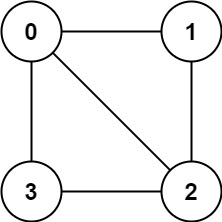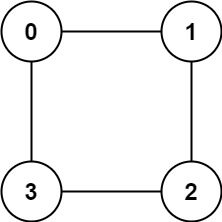785 Is Graph Bipartite
There is an undirected graph with n nodes, where each node is numbered between 0 and n - 1. You are given a 2D array graph, where graph[u] is an array of nodes that node u is adjacent to. More formally, for each v in graph[u], there is an undirected edge between node u and node v. The graph has the following properties:
There are no self-edges (
graph[u]does not containu).There are no parallel edges (
graph[u]does not contain duplicate values).If
vis ingraph[u], thenuis ingraph[v](the graph is undirected).The graph may not be connected, meaning there may be two nodes
uandvsuch that there is no path between them.
A graph is bipartite if the nodes can be partitioned into two independent sets A and B such that every edge in the graph connects a node in set A and a node in set B.
Return true if and only if it is bipartite.
Example 1:
Input: graph = [[1,2,3],[0,2],[0,1,3],[0,2]]
Output: false
Explanation: There is no way to partition the nodes into two independent sets such that every edge connects a node in one and a node in the other.Example 2:
Input: graph = [[1,3],[0,2],[1,3],[0,2]]
Output: true
Explanation: We can partition the nodes into two sets: {0, 2} and {1, 3}.Constraints:
graph.length == n1 <= n <= 1000 <= graph[u].length < n0 <= graph[u][i] <= n - 1graph[u]does not containu.All the values of
graph[u]are unique.If
graph[u]containsv, thengraph[v]containsu.
如题,解法,bfs,用两种颜色填图里的点,规则是邻居跟自己要是填不同颜色。如果填着填着发现颜色相同的话,返回false。这题在geeksforgeeks上有oj,不过是用邻接表的。其实填色还能用这个color[nei] = color[node] ^ 1; solution是用stack做的,可以参考参考。其实就是把图里的点和边都过一遍,所以T:O(n + e), S:O(n)
// n年后再写
public boolean isBipartite(int[][] graph) {
if (graph == null) {
return false;
}
int n = graph.length;
int[] colored = new int[n];
boolean bipartite = true;
for (int i = 0; i < n; i++) {
if (colored[i] == 0) {
bipartite = bipartite & fillColor(i, graph, colored);
}
}
return bipartite;
}
private boolean fillColor(int curNode, int[][] graph, int[] colored) {
Queue<Integer> queue = new LinkedList<>();
queue.offer(curNode);
colored[curNode] = 1;
while (!queue.isEmpty()) {
int node = queue.poll();
int[] neighbor = graph[node];
for (int nei : neighbor) {
if (colored[nei] == 0) {
queue.offer(nei);
colored[nei] = 0 - colored[node];
} else {
if (colored[nei] == colored[node]) {
return false;
}
}
}
}
return true;
}
/*Complete the function below*/
class GfG {
static int[] colored;
public static boolean isBipartite(int G[][],int src,int V) {
if (G == null || G.length == 0 || G[0].length == 0) {
return false;
}
colored = new int[V];
Arrays.fill(colored, -1);
for (int v = 0; v < V; v++) {//因为图可能不联通,这里多加一层,把图全遍历完
if (colored[v] == -1) {
if (!fillColor(src, G, V)) {
return false;
}
}
}
return true;
}
private static boolean fillColor(int src, int G[][], int V) {
Queue<Integer> queue = new LinkedList<>();
queue.offer(src);
colored[src] = 1;
while (!queue.isEmpty()) {
int node = queue.poll();
for (int v = 0; v < V; v++) {
if (G[node][v] == 1) {
if (colored[v] == -1) {
colored[v] = 1 - colored[node];
queue.offer(v);
} else {
if (colored[v] == colored[node]) {
return false;
}
}
}
}
}
return true;
}
}
// 参考答案
public boolean isBipartite(int[][] graph) {
int n = graph.length;
int[] color = new int[n];
Arrays.fill(color, -1);
for (int start = 0; start < n; ++start) {
if (color[start] == -1) {
Stack<Integer> stack = new Stack();
stack.push(start);
color[start] = 0;
while (!stack.empty()) {
Integer node = stack.pop();
for (int nei: graph[node]) {
if (color[nei] == -1) {
stack.push(nei);
color[nei] = color[node] ^ 1;
} else if (color[nei] == color[node]) {
return false;
}
}
}
}
}
return true;
}Last updated
Was this helpful?